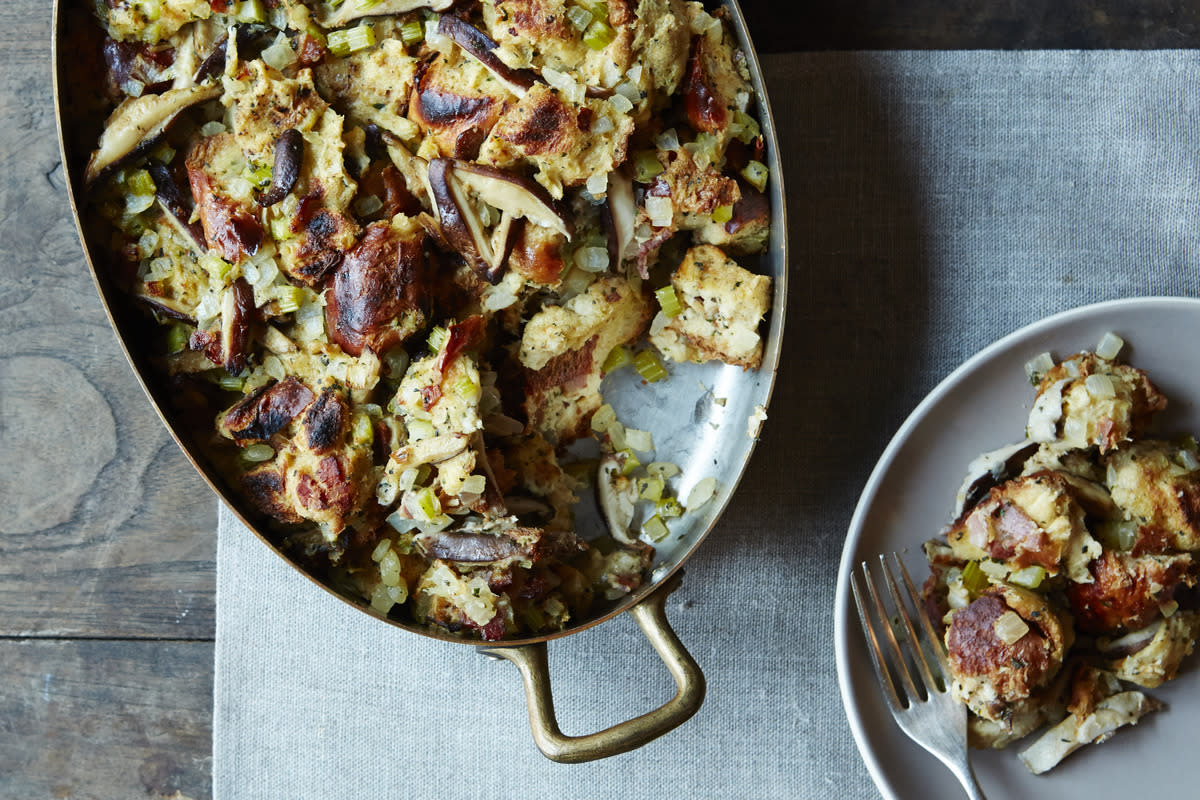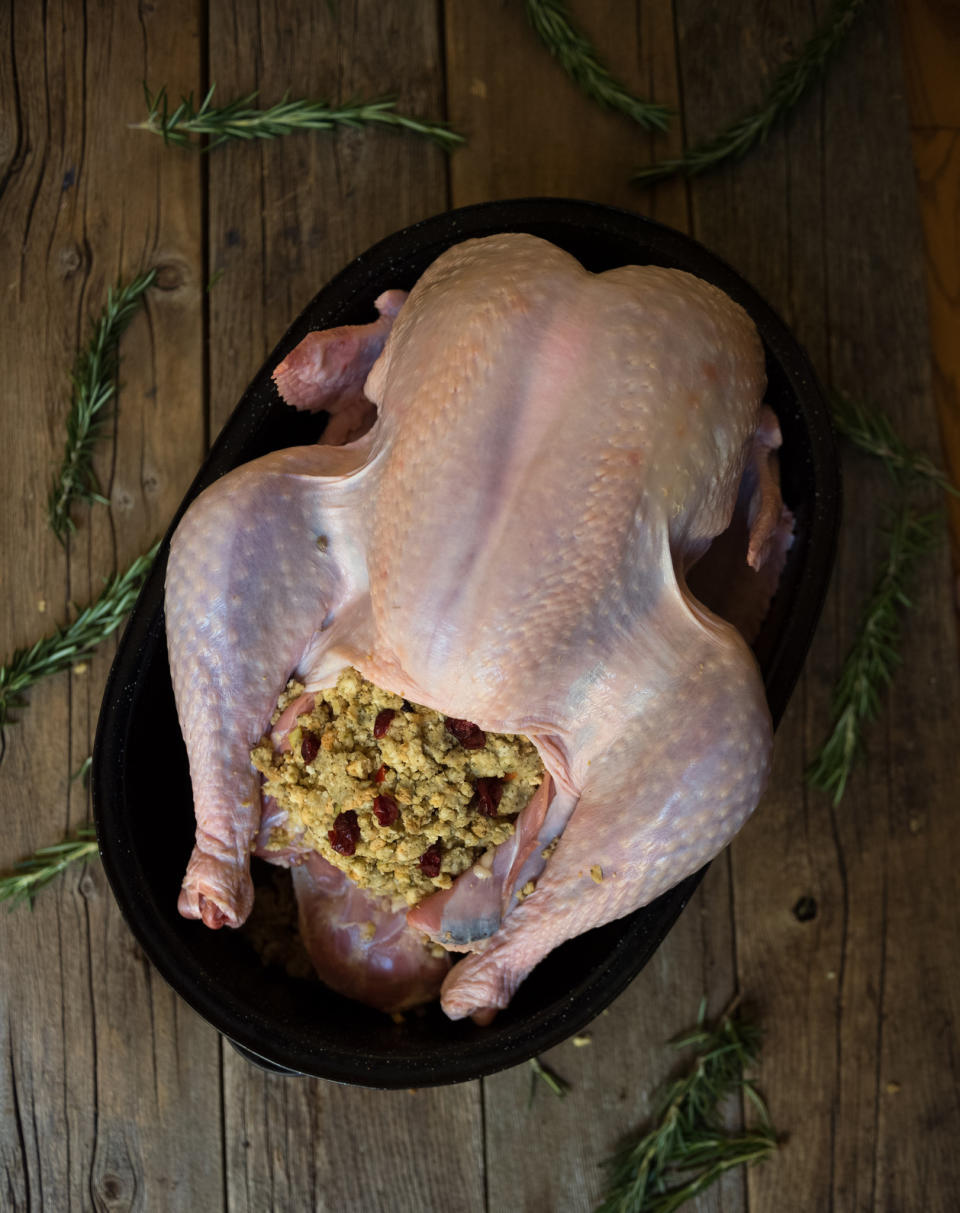Why Do We Eat Stuffing on Thanksgiving? You Can Thank the Peacock

Photo: Offset/Mark Weinberg
When one thinks of the very first Thanksgiving feast, lovingly prepared by pilgrims to give thanks for the hospitality shown them by their Native American hosts, a classic bread stuffing likely factors into the menu.
Yet that’s probably not what happened. To start, wheat flour was rare in those days, which meant that the kind of stuffing familiar to us — buttery cubed bread enriched with herbs, garlic, and turkey drippings — simply wasn’t a possibility. But the problems don’t end there.
“There’s no such thing as the original Thanksgiving feast,” explained Andrew Smith, a culinary historian and author of The Turkey: An American Story. “[It] is really an invention of the late 19th century.”
More: 14 Stuffing Recipes to Cook Outside the Bird
Yes, there really was an autumn harvest feast held in 1621 that was attended by the Plymouth colonists and Wampanoag Indians, but the menu hardly looked like today’s Thanksgiving spread. Plus, the event was more about cementing a military alliance than showing thanks. (The pilgrims even “exercised arms” at the feast, which likely meant a target practice intended to show off their firepower.)
Various fall feasts were celebrated across New England during the two centuries that followed, although they were often held at different times between October and December (it depended on when a community’s harvest occurred) and there was hardly a codified set of standard dishes. A proclamation by President George Washington designated a national day of Thanksgiving in 1789 on November 26, but it wasn’t until 1863 that President Abraham Lincoln officially made Thanksgiving Day a federal holiday, a rallying event to unify the country in the midst of the Civil War.
Related: 13 Thanksgiving Dinner Bread Recipes: Cornbread, Biscuits, and More
That said, the idea of stuffing a turkey would have been familiar to European settlers in the New World. Turkeys themselves are native to the Americas (and there’s even evidence that Aztecs stuffed them with fiery chilis, Smith said). When Spanish conquistador Hernán Cortés and his men landed in the Americas more than a century earlier, they were struck by the plumed birds strutting all around.
“He takes one look at this bird and says, ‘This is really great — the male spreads his feathers a lot like the peacock does,’” Smith explained. This was especially exciting because peacocks were the chosen delicacy of European royalty at the time, and Cortés’s crew wasted no time exporting the bird across the Atlantic, making it the first New World food to be adopted in Europe. Given its physical resemblance to a peacock, Europeans prepared it in the exact same fashion: stuffing them, then roasting the whole thing.

Photo: Stocksy
Related: Do Thanksgiving Like Thomas Keller With These 9 Superb Recipes
“By 1550, you have large numbers of western Europeans preparing [turkeys] for Christmas,” Smith said. “So when Europeans come to the United States, they know what turkey is.” Turkeys became a mainstay of colonial cuisine because they were easy to raise, plus their large size meant a single bird could feed a large number of people.
In addition to European culinary heritage, early Americans liked to stuff their birds for several reasons. For one, modern stovetops weren’t widely available until the 18th century — birds were roasted on a spit over an open fire — which made it difficult to cook side dishes at the same time. The solution? Simply cook the sides in the bird.
Related: 9 Cookbook Authors’ Favorite Thanksgiving Sides
Moreover, preparing stuffing this way meant more bang for one’s caloric buck. Juices from the turkey soaked into the stuffing, infusing it with fat and flavor. "You’ve got those juices, and those juices taste great,” Smith said. “Today lots of people are wary of stuffing because it typically has a lot of fat, but historically, you’d want every calorie you could get.” Plus, since preservatives didn’t yet exist, bread would go hard a day after baking; juices from the turkey rehydrated it, which prevented waste.
So how did we end up with so many different stuffing recipes? The answer is simple: Ingredients differed depending on what was readily available in a given area. That meant corn bread in the South, where corn was historically raised, and seafood like oysters and clams in coastal areas. People living in rice-growing areas stuffed their birds with rice, and those potato-growing regions with potatoes.
Related: How to Make Gluten-Free Stuffing Muffins
“There’s nothing that surprised me when it came to stuffing, because everything was added in!” Smith said. “Historically, there is nothing that is common about stuffing recipes, until you get to the commercial stuffing of today.”
According to Smith, the first ever commercial stuffing was manufactured in 1919 by a Los Angeles-based enterprise called Mrs. Cubbison’s Foods, a brand that still exists today. Its namesake and co-founder, Sophie Cubbison, relied on Melba toast — a crisp, thinly sliced toast — as the stuffing’s main ingredient. More commercially-packaged stuffings followed, including the popular brand Stove Top in 1972, had the effect of narrowing the scope of stuffings across the country.
Related: How to Make Thanksgiving Dinner for 6 People for Under $50
By then, bread stuffing was already a standard part of the Thanksgiving fable. This was thanks to late-19th century textbooks, which often included descriptions of dishes thought to have been served at the “first” Thanksgiving (though we know now they weren’t always accurate). “In one sense, there would have been much greater diversity of foods you would have served and stuffed into the turkey before the 19th century,” Smith said.
At any rate, these days Americans are bringing variety back to their stuffings by embracing different recipes with roots all over the country, whether that be Southern-inspired cornbread stuffing flecked with juicy pears, New Brunswick-style potato stuffing, or even gluten-free stuffing enriched with fennel and green apples. Other stuffings incorporate the traditions of more newly-arrived Americans, including Chinese sausage and chestnut stuffing and Jewish-inflected challah stuffing.
When you think about it, what could be more American than that?
In need of Thanksgiving stuffing recipes? We’ve got you covered:
Sausage Stuffing Recipe from Thomas Keller’s Ad Hoc
Stuffed Herb-Rubbed Roast Turkey with Gravy from ‘The Food Lab’
Holiday Stuffing with Sausage, Pecans, and Apples from ‘Farmhouse Rules’

 Yahoo Movies
Yahoo Movies 
